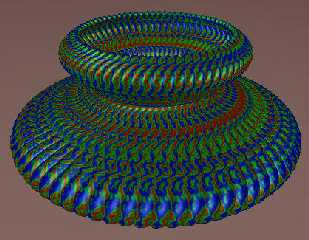|
 |
I quickly found out that the arrays aren't even needed if the splines are
defined on the spot. Passing arrays to splines is a powerful feature still,
since an array can easily be read in from a file. I'm already working this
into animations - spline vectors as a function of the clock! Here's the
code for the exotic vase:
#declare vase=union{
#declare index2=0;
#while (index2<360)
sphere_sweep {
cubic_spline
25,
#declare index=0;
#while (index<1)
#declare rad=10-index*7;
#declare myvector=<sin(index*pi*3)*2+rad,index*10,0>;
#declare myrad=rad/15;
myvector,myrad // <---------------------right here is where the
vectors and size data are inserted in the spline
#declare index=index+.04;
#end
texture {
pigment{
agate
color_map{
[0.00 color rgb <1,0,0>]
[0.50 color rgb <0,1,0>]
[1.00 color rgb <0,0,1>]
}
}
finish {ambient.3 specular .4 diffuse .35}
}
rotate <20,index2,0>
}
#declare index2=index2+5;
#end
}
---
Outgoing mail is certified Virus Free.
Checked by AVG anti-virus system (http://www.grisoft.com).
Version: 6.0.590 / Virus Database: 373 - Release Date: 2/16/2004
---
File has not been scanned
Checked by AVG anti-virus system (http://www.grisoft.com).
Version: 6.0.590 / Virus Database: 373 - Release Date: 2/16/2004
Post a reply to this message
Attachments:
Download 'vase.jpg' (70 KB)
Preview of image 'vase.jpg'

|
 |




![]()